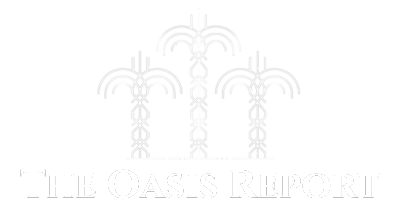
Reuters/Nicoco Chan
The Gulf countries rely heavily on international trade. Exports account for 30 percent of Saudi Arabia’s GDP, nearly 50 percent in Bahrain, Kuwait and Qatar, and almost 70 percent in the UAE and Oman.
As such, economic developments in the rest of the world deeply affect the region’s oil-rich economies.
These countries tend to trade most heavily with Asian nations such as China, Japan, South Korea and India, followed by members of the European Union. Crude oil, refined products and natural gas dominate the export mix.
In most Gulf export markets, GDP growth has been slow for several years, which explains why prices for crude oil, refined products and natural gas have fallen sharply from 2022 highs.
Perhaps no country’s economic activity plays a bigger role in determining the global price of crude oil than China. Over the past 20 years, prices for crude and refined products have tended to rise and fall with the pace of China’s economic growth – with a lag of usually about one year.
Chinese growth hit peaks in 2007, 2010, 2017 and 2021. In each case, prices for crude oil and its refined products peaked one year later.
Real estate-related activities have driven China’s economic growth. By the middle of the 2010s, they accounted for nearly 30 percent of its GDP. But in recent years, that sector has begun to contract at almost 10 percent yearly, slowing the pace of annual growth in China to about 4 percent, from 7 percent.
China has also led a revolution in electric vehicles, with EV sales topping 35 percent in 2023 and 50 percent in 2024, slowing demand for crude oil imports.
Natural gas prices have also fallen across Europe and Asia since hitting a peak in 2022. The emergence of the US as a major exporter of natural gas is helping to cap the price of LNG and align the global cost of natural gas more closely with the Henry Hub benchmark – the pricing point for natural gas futures on the New York Mercantile Exchange.
Outside China, growth across Europe and Asia has been slow. Consumer-spending growth in Japan has ground to a halt as the falling yen has raised the cost of imports. South Korea has found itself in a similar bind.
Meanwhile, the eurozone and the UK have been growing at less than 1 percent per year, with some countries seeing a mild contraction in economic activity.
India has been a bright spot, producing 7 percent growth in 2023 and around 5.5 percent in 2024. Even so, India’s economy is about a quarter the size of China’s and New Delhi hasn’t achieved the kind of double-digit growth that Beijing managed between 1980 and 2010.
The US economy has also been robust, growing at 2.5 percent in 2024 after rising by 3.2 percent in 2023. Gulf nations do relatively little crude oil trade with the US, however, as American production has risen from 5.5 million barrels per day to 13.5 million over the past 16 years.
Rising US production has replaced about half of what Opec removed from the market over the past two years. This, along with soft demand for crude oil and its refined products, has helped keep the price of crude oil trading in a narrow range for much of that period.
The world experienced a tremendous tightening of monetary policy in 2022 and 2023, the lagged effects of which could slow growth in 2025.
Growth rates slowed in most major economies in 2024 – and the increased uncertainty from rapidly changing public policy could put further downward pressure on growth.
While countries in the Gulf continue to show strong economic dynamism domestically, the external environment is mixed.
Increasing global protectionism combined with a slower pace of growth in China, India, Europe and North America could limit demand growth for some of the Gulf’s exports.
That said, the possibility of fiscal stimulus in China, Germany and the US could create upside surprises for the prices of major commodity exports in the months ahead.
Erik Norland is chief economist and managing director of CME Group



